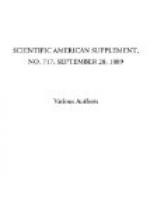On some grand scale ozone is formed in the air, and my former friend and colleague, the late Dr. Moffatt, of Hawarden, with whom I wrote a paper on “Meteorology and Disease,” read before the Epidemiological Society in 1852-53, described what he designated ozone periods of the atmosphere, connecting these with storms. When the atmospheric pressure is decreasing, when with that there is increasing warmth and moisture, and when south and southwesterly winds prevail, then ozone is active; but when the atmospheric pressure is increasing, when the air is becoming dry and cold, and north and northeasterly winds prevail, then the presence of ozone is less active. These facts have also been put in another way, namely, that the maximum period of ozone occurs when there is greatest evaporation of water from the earth, and the minimum when there is greatest condensation of water on the earth; a theory which tallies well with the idea that ozone is most freely present when electricity is being produced, least present when electricity is in smallest quantity. Mr. Buchan, reporting on the observations of the Scottish Meteorological Society, records that ozone is most abundant from February to June, when the average amount is 6.0; and least from July to January, when the average is 5.7; the maximum, 6.2, being reached in May, and the minimum, 5.3, in November. This same excellent observer states that “ozone is more abundant on the sea coast than inland; in the west than the east of Great Britain; in elevated than in low situations; with southwest than with northeast winds; in the country than in towns; and on the windward than the leeward side of towns.”
Recently a very singular hypothesis has been broached in regard to the blue color of the firmament and ozone. It has been observed that when a tube is filled with ozone, the light transmitted through it is of a blue color; from which fact it is assumed that the blue color of the sky is due to the presence of this body in the higher atmospheric strata. The hypothesis is in entire accord with the suggestion of Professor Dove, to which Moffatt always paid the greatest respect, viz., that the source of ozone for the whole of the planet is equatorial, and that the point of development of ozone is where the terrestrial atmosphere raised to its highest altitude, at the equator, expands out north and south in opposite directions toward the two poles, to return to the equator over the earth as the trade winds.
It is necessary for all who would understand the applications of ozone for any purpose, whether for bleaching purposes or pure chemical purposes, or for medical or sanitary purposes, to understand these preliminary facts concerning it, facts which bring me to the particular point to which I wish to refer to-day.
In my essay describing the model city, Hygeiopolis, it was suggested that in every town there should be a building like a gas house, in which ozone should be made and stored, and from which it should be dispensed to every street or house at pleasure. This suggestion was made as the final result of observations which had been going on since I first began to work at the subject in 1852. It occurred to me from the moment when I first made ozone by Schonbein’s method, that the value of it in a hygienic point of view was incalculable.




